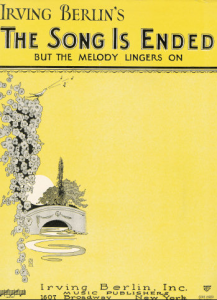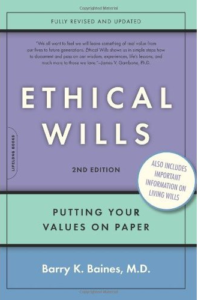PART VII: WRAPPING UP
“The song is ended (but the melody plays on). “
~Irving Berlin (composer) & Beda Loehner (lyricist)
 All good things must come to an end. Hopefully this series has succeeded in helping both artists and their attorneys understand the unique complexities that are often involved in an artist’s estate plan. As mentioned previously in this series, it is always recommended to start the estate planning process sooner rather than later. Realistically, people are not always able to jump on the estate planning bandwagon when they want. However, there are many things artists can do on their own in preparation for their estate planning process. This article is specifically aimed at artists in assisting them pull together as many pieces of the puzzle as possible prior to meeting with an estate planning attorney. An easy way to remember the list of homework is to think of the oral exams given in graduate school. The list of ORROLS homework for estate planning is as follows:
All good things must come to an end. Hopefully this series has succeeded in helping both artists and their attorneys understand the unique complexities that are often involved in an artist’s estate plan. As mentioned previously in this series, it is always recommended to start the estate planning process sooner rather than later. Realistically, people are not always able to jump on the estate planning bandwagon when they want. However, there are many things artists can do on their own in preparation for their estate planning process. This article is specifically aimed at artists in assisting them pull together as many pieces of the puzzle as possible prior to meeting with an estate planning attorney. An easy way to remember the list of homework is to think of the oral exams given in graduate school. The list of ORROLS homework for estate planning is as follows:
- Organize
- Research
- Reach Out
- Legacy Statement
Organize
Now is the time to pull together the list of all your work and important artistic contacts. This can be formalized in a database, spreadsheet, or a simple document. You will want to include as much information as possible.
Remember, although this is helpful for you, as the artist, it is intended to help guide others after you are gone. Include the information you think will facilitate that goal. Followers of this series will recall that this is the Artist’s Inventory from Part IV. Here is a list of the minimum information I advise artist clients to include:
- Name of the Art
- Medium (painting, statue, film, photo, etc.) – Be as specific as possible here.
- Size
- Date Created
- Number of Originals and Copies and Their Locations
- History of Display (galleries, museums, performances, release dates, etc.)
- Any Associated Contracts and Their Locations
- Important People (agents, managers, attorneys, location contacts, etc.)
- List of Registered Copyrights, Trademarks or Patents
- Instructions for Care, Use, Dispersal and Disposal
- Important Notes
Research
Artists can also do a little legwork on their own. Find organizations in your area that can help advise you or put you in touch with people who can.
 For example, Springboard for the Arts is an amazing and innovative nonprofit organization in the Twin Cities that provides artists with services ranging from professional development to medical vouchers to referrals to their extensive network of attorneys. Some other organizations artists might find useful are:
For example, Springboard for the Arts is an amazing and innovative nonprofit organization in the Twin Cities that provides artists with services ranging from professional development to medical vouchers to referrals to their extensive network of attorneys. Some other organizations artists might find useful are:
- Minnesota State Arts Board
- A list of Minnesota nonprofit arts organizations can be found here.
- Minnesota Citizens for the Arts
- Metropolitan Regional Arts Council
- COMPAS (Community Programs in the Arts)
- MNArtists.org
Reach Out
One of the hardest conversations I have with my estate planning clients, both artists and non-artists, is to encourage them to talk with their loved ones now about the inevitable circumstance of their deaths. We all want to believe we will be around forever, but until Ray Kurzweil’s Singularity arrives, the reality is that we are all mortal beings. Discussing death with your family and loved ones may be the last thing on your Honey Do list, but it is absolutely one of the best ways to ensure that they understand your perspective on your own death. Having a candid conversation can help avoid problems later and helps provide your loved ones with some guidance for when you are no longer here.
Legacy Statement
 In Part IV of this series, I described the Artists’s Legacy Statement, also known as an Ethical Will. Artists will find this document particularly useful in helping others understand their thoughts and feelings about their art. As this is not technically a legal document, artists can draft this piece without the assistance of an attorney. It is a perfect place to aggregate ideas, views, philosophies, biographies, and stories about their lives as artists and their works. There are many resources available online and in print on the topic. One of the best guides on the market to assist you on this journey is Dr. Barry K. Baines Ethical Wills: Putting Your Values on Paper.
In Part IV of this series, I described the Artists’s Legacy Statement, also known as an Ethical Will. Artists will find this document particularly useful in helping others understand their thoughts and feelings about their art. As this is not technically a legal document, artists can draft this piece without the assistance of an attorney. It is a perfect place to aggregate ideas, views, philosophies, biographies, and stories about their lives as artists and their works. There are many resources available online and in print on the topic. One of the best guides on the market to assist you on this journey is Dr. Barry K. Baines Ethical Wills: Putting Your Values on Paper.
I encourage all artists to actively participate in protecting their lives works. Hopefully this series has sparked some initiative in taking control of your creative legacy.
SUPPORT YOUR LOCAL ARTS COMMUNITY

I live in Nashville, TN. I am a professional visual artist. I have been unable to find an attorney who understands the components and concerns of an artist’s estate.
Are you able to recommend anyone to draw up my will in the Nashville area? I have consulted TN Commission for the Arts, Metro Arts Commission and several attorneys but no one has any concrete suggestions of who could help me appropriately.
Thank you so much. Your articles on estates for artists are essential info.
Hi Laura,
Thanks so much for the comment. We suggest you contact the author of this blog post, Christi Cottrell, directly. She would be happy to help point you to an attorney in TN that could be of service to you. Christi’s email is: christi.cottrell.esq@gmail.com.
Good luck!